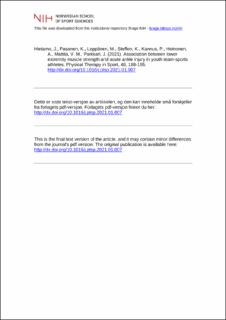| dc.contributor.author | Hietamo, Jussi | |
| dc.contributor.author | Pasanen, Kati | |
| dc.contributor.author | Leppänen, Mari | |
| dc.contributor.author | Steffen, Kathrin | |
| dc.contributor.author | Kannus, Pekka | |
| dc.contributor.author | Heinonen, Ari | |
| dc.contributor.author | Mattila, Ville M. | |
| dc.contributor.author | Parkkari, Jari | |
| dc.date.accessioned | 2022-03-09T08:27:09Z | |
| dc.date.available | 2022-03-09T08:27:09Z | |
| dc.date.created | 2021-04-09T18:04:48Z | |
| dc.date.issued | 2021 | |
| dc.identifier.citation | Physical Therapy in Sport. 2021, 48(March 2021), 188-195. | en_US |
| dc.identifier.issn | 1466-853X | |
| dc.identifier.uri | https://hdl.handle.net/11250/2983885 | |
| dc.description | I Brage finner du siste tekst-versjon av artikkelen, og den kan inneholde ubetydelige forskjeller fra forlagets pdf-versjon. Forlagets pdf-versjon finner du på www.sciencedirect.com / In Brage you'll find the final text version of the article, and it may contain insignificant differences from the journal's pdf version. The original publication is available at www.sciencedirect.com | en_US |
| dc.description.abstract | Objectives: To investigate lower extremity muscle strength as risk factor for an acute ankle injury in youth athletes. Design: Cohort study. Setting: Basketball and floorball clubs. Participants: 188 youth (≤21) male and 174 female athletes. Main outcome measures: 1RM leg press, maximal concentric isokinetic quadriceps and hamstrings as well as maximal isometric hip abductor strength were measured and athletes were followed for an acute ankle injury up to three years. Cox regression models were used in statistical analyses. Results: In males, greater 1RM leg press and maximal quadriceps strength increased the risk of any type of acute ankle injury (Hazard ratio [HR] for 1 SD increase, 1.63 [95% CI, 1.12–2.39] and 1.43 [95% CI, 1.01–2.01], respectively). In females, greater 1RM leg press and difference between legs in hip abduction strength increased the risk of acute non-contact ankle injury (HR for 1 SD increase, 1.44 [95% CI, 1.03–2.02] and 1.44 [95% CI, 1.03–2.00], respectively). However, ROC curve analyses showed AUC:s of 0.57–0.64 indicating “fail” to “poor” combined sensitivity and specifity of these tests. Conclusion: Greater strength in both sexes along with asymmetry in hip abductor strength in females increased the risk of acute ankle injury. | en_US |
| dc.language.iso | eng | en_US |
| dc.subject | sport injury | en_US |
| dc.subject | injury risk | en_US |
| dc.subject | youth sport | en_US |
| dc.title | Association between lower extremity muscle strength and acute ankle injury in youth team-sports athletes | en_US |
| dc.type | Peer reviewed | en_US |
| dc.type | Journal article | en_US |
| dc.description.version | acceptedVersion | en_US |
| dc.source.pagenumber | 188-195 | en_US |
| dc.source.volume | 48 | en_US |
| dc.source.journal | Physical Therapy in Sport | en_US |
| dc.identifier.doi | 10.1016/j.ptsp.2021.01.007 | |
| dc.identifier.cristin | 1903288 | |
| dc.description.localcode | Institutt for idrettsmedisinske fag / Department of Sports Medicine | en_US |
| cristin.ispublished | true | |
| cristin.fulltext | postprint | |
| cristin.qualitycode | 1 | |
